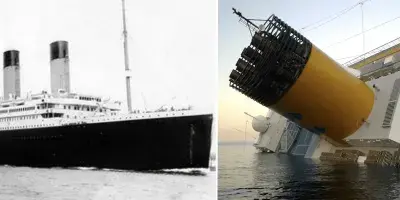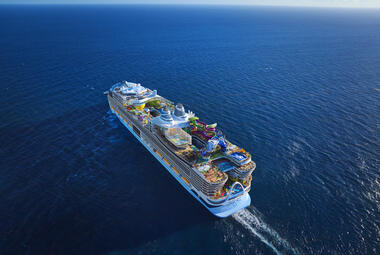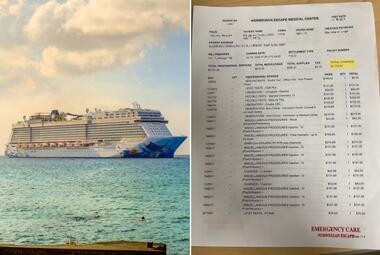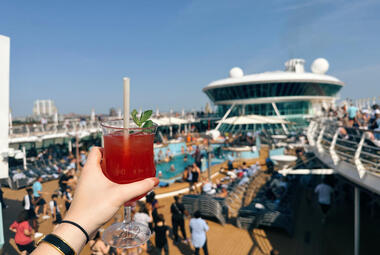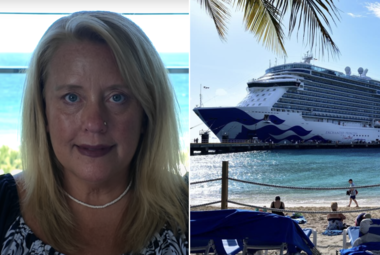Today's cruise ships are built to withstand intense weather conditions. Plus, cruise lines actively monitor the weather to avoid storms if possible. That being said, you have probably wondered how many cruise ships have sunk at one point or another.
Every year, we are reminded of the Titanic tragedy. And while not a true "cruise ship," as Titanic was technically an ocean liner, it reminds us that we should always be prepared for the unexpected while at sea, especially since she was deemed to be unsinkable.
Read more: The cruise ship muster drill: What is it and why it's important
Thankfully, very few cruise ships have actually sunk in modern history. Even so, the Titanic's sinking impacted maritime law so much that there are more than enough lifeboats for all passengers and crew onboard any given sailing.
Within the last 111 years, over 20 cruise ships and ocean liners have sunk.
Titanic (April 1912)
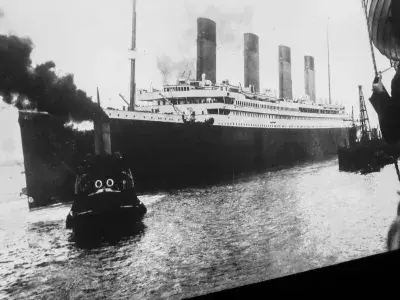
One of the most infamous sinkings was that of the Titanic, which sank on her maiden voyage across the Atlantic Ocean.
On the night of April 14, 1912, the ship collided with an iceberg. A little over two-and-a-half hours later, the ship was completely submerged underwater. Unfortunately, the majority of passengers were unable to safely evacuate, as there were not enough lifeboats for everyone onboard.
With over 1,500 deaths, this was one of the deadliest maritime disasters in history. This was partly due to the fact that the ship was sailing in freezing waters, meaning that those who were unable to secure a spot in a lifeboat had a very slim chance of survival.
Empress of Ireland (May 1914)
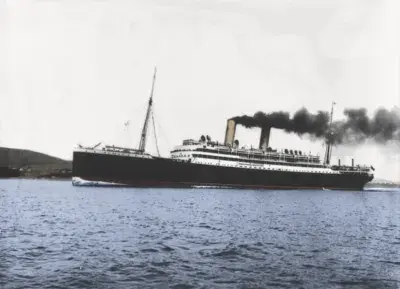
(Photo retrieved from Wikipedia on September 5, 2023. Originally uploaded by user HefePine23, license CC BY-SA 2.0)
A little over two years after the sinking of the Titanic, another ocean liner met their tragic fate after colliding with another ship.
In May 1914, Empress of Ireland, an ocean liner carrying close to 1,500 passengers, struck Norwegian collider Storstad. While both ships had been able to see each other earlier in the day, fog later limited their visibility.
A total of 1,012 passengers and crew were killed, and she was just four voyages shy of completing 1,000 successful sailings.
Lusitania (May 1915)

(Photo retrieved from Wikipedia on September 5, 2023. Originally taken by George Grantham Bain and uploaded by user Scewing. This image is available from the United States Library of Congress's Prints and Photographs division under the digital ID cph.3g13287)
Have you ever heard of Cunard Line? Well, they have been operating ships since 1940. They are still around today, and you can sail on Queen Mary 2, the last ocean liner in service.
RMS Lusitania was a ship built for Cunard Line that was the largest passenger ship in the world for a short three months.
On May 7, 1915, Lusitania was struck by torpedo sent by a German U-Boat while she was sailing off the coast of Ireland en route to Liverpool, England. The ship began to list quicker than expected, meaning that only six lifeboats could be launched.
In total, nearly 1,200 people lost their lives.
Britannic (November 1916)

(Photo retrieved from Wikipedia on September 5, 2023. Current version uploaded by user Antonynizh. Original version uploaded by user Britannic, {{PD-US-expired}})
Britannic was the younger sister of Olympic (1911) and Titanic (1912), and although she was meant to be a passenger ship, her purpose changed as a result of the First World War breaking out right before her launch.
She entered service as a hospital ship in December 1915. Less than a year later in November 1916, she struck a German naval mine while sailing through the Kea Channel between the Greek islands of Kea and Makronisos and sank 55 minutes later.
Thankfully, there were minimal casualties, as mostly everyone onboard was able to escape on the 35 lifeboats that had been successfully launched. Still, though, about 30 people lost their lives during the sinking of the Britannic.
Principessa Mafalda (October 1927)

(Photo retrieved from Wikipedia on September 5, 2023. Originally uploaded by user HTFP, {{PD-US}})
The Principessa Mafalda was an Italian ocean liner that was named after Princess Mafalda of Savoy, who was the second daughter of King Victor Emmanuel III.
In 1909, the ship entered service and sailed between Genoa and Buenos Aires. In October 1927, she sank off the coast of Brazil due to a propeller shaft that broke and damaged the ship's hull. A little over 300 people were killed.
Saint-Philibert (June 1931)

(Photo retrieved from Wikipedia on September 5, 2023. Originally uploaded by user F1jmm, {{PD-US-not renewed}})
The Saint-Philibert capsized and sank on June 14, 1931 while sailing off the coast of France, resulting in the deaths of nearly 500 people. Only 8 passengers managed to survive.
Prior to her distance, the small cruise ship would offer summer voyages around the French coast.
Georges Philippar (May 1932)
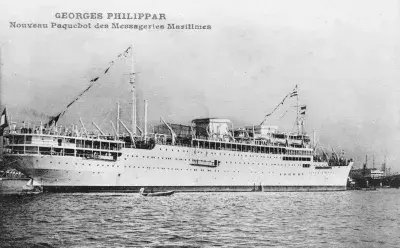
(Photo retrieved from Wikipedia on September 5, 2023. Originally uploaded by user Siren-Com, {{PD-US-no notice}})
On the second leg of her maiden voyage, the French ocean liner Georges Philippar sank near present-day Yemen, in which 54 people lost their lives.
The cause of the incident was an electrical fault; a fire had broken out in one of the luxury cabins thanks to a faulty light switch that caused a spark to ignite the wood paneling ablaze.
Prior to her sailing, there had been concerns about the safety of the ship. In fact, the ship's launch was initially going to be delayed in order to give workers time to correct all defects. However, these concerns were later ignored in order to avoid any delay penalties.
SS Morro Castle (September 1934)
While en route from Havana, Cuba to New York City, SS Morro Castle, an American ocean liner operated by Ward Line, caught fire and aground on September 8, 1934.
The night before, Captain Robert Rennison Willmott, the ship's captain, suddenly died after complaining about a stomach ache, and command of the ship was passed to Chief Office William Warms.
In total, there were 137 casualties. A lot of blame was placed on the crew, as they did not handle the emergency properly. For instance, while the lifeboats were able to collectively hold up to 408 people, they were launched with only 85.
Empress of Britain (October 1940)
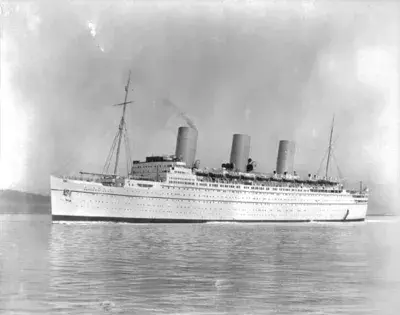
(Photo retrieved from Wikipedia on September 5, 2023. Originally taken by Stewart Bale and uploaded by user Ashley Bodiguel, {{PD-US-no notice}})
Empress of Britain, an ocean liner measuring a little over 42,000 gross registered tons, was the largest ocean liner sunk during World War II, as well as the largest ship sunk by a U-Boat during the War.
She was first bombed from above on October 26 before being sunk by a torpedo launched by German U-Boats on October 28.
Most of the 416 crew members, 2 gunners, and 205 passengers were able to abandon the ship, leaving few people onboard. In total, 45 people were killed.
Andrea Doria (July 1956)

(Photo retrieved from Wikipedia on September 5, 2023. Originally uploaded by user Marinaio56)
On July 25, 1956, Andrea Doria and MS Stockholm collided while en route to New York City. 51 people were killed; however, this sinking represents one of the largest rescues in maritime history. The ship's crew was able to use improved communication systems to initiate rescue efforts and get aid from other ships.
Only five people died onboard Stockholm. The damage to Andrea Doria, however, meant the ship was unsalvageable. Those who perished did so as a result of the initial collision.
Bianca C (October 1961)
The first time Bianca C sank was before she was actually completed. She was scuttled by the Germans during World War II. After, the hull was raised, and she was refitted to be a cruise ship. She was first sold to Panama's Arosa Line and became the company's flagship; however, the company eventually had to sell her to Costa Line. It was then that she received the name Bianca C after one of the owner's daughters.
On October 22, 1961, an explosion occurred in the ship's engine room while the ship was docked off the coast of Grenada, which resulted in subsequent fires to break out. Thankfully, everyone but one person killed in the initial explosion was able to make it off of the ship before it sank.
Angelina Lauro (September 1979)
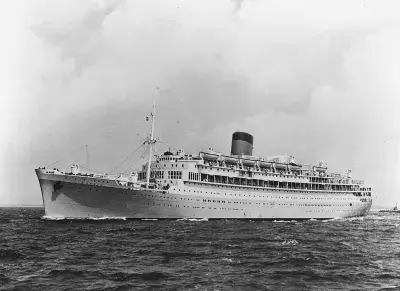
(Photo retrieved from Wikipedia on September 5, 2023. Originally uploaded by user Mr.Nostalgic, license CC0)
Angelina Lauro did not spend her entire career operating as a cruise ship. She first entered service in 1939 as MS Oranje, and while she was intended to serve as a passenger ferry, she was kept in Indonesia until she was converted into a hospital ship.
After the war ended, she sailed as a passenger liner for about eleven years, even sailing around the world from Amsterdam to Australia via the Panama Canal and back through Singapore and the Suez Canal.
In 1964, she was sold to Lauro Lines and was refitted as a cruise ship. On March 6, 1966, she departed on her maiden voyage as Angelina Lauro. In the late 70s, she was chartered by Costa Lines, during which she caught fire while docked in Saint Thomas. The fire burned for several days, and before she was able to be towed to a scrapyard, the ship's weakened hull began to fill with water a few months later in September. She sank on September 24, 1979.
MS Mikhail Lermentov (February 1986)

(Photo retrieved from Wikipedia on September 5, 2023. Originally taken by John Rostron and uploaded by user Magnus Manske, license CC BY-SA 2.0)
MS Mikhail Lermentov was an ocean liner operated by the Soviet Union's Baltic Shipping Company that entered service in 1972. Ten years later, she was upgraded to serve as a cruise ship.
On February 6, 1986, she departed from Sydney on a two week cruise around New Zealand. Ten days later while sailing past Cape Jackson, the ship struck rocks. Out of the total of 743 crew and passengers onboard, the majority were able to make it off the ship on lifeboats. Only one causality was reported: crew engineer Paval Zagladimov.
SS Admiral Nakhimov (August 1986)
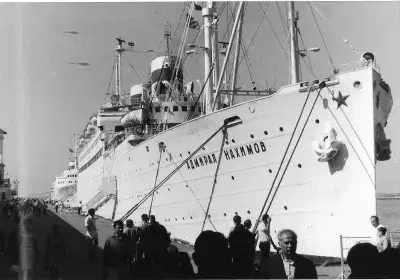
(Photo retrieved from Wikipedia on September 5, 2023. Originally taken and uploaded by Dr. Hans Jonke [AndreasJonke], license CC BY-SA 4.0)
SS Admiral Nakhimov entered service in 1925 as SS Berlin, a passenger liner of the German Weimar Republic. It was later converted into a hospital ship before becoming a Soviet Union passenger ship.
In August 1986, the ship collided with another ship in the Tsemes Bay. It did not take long for the ship to sink, and a total of 423 perished as a result of the incident. This was the third, and final, time that the ship had sunk.
MV Jupiter (October 1988)
MV Jupiter was a Greek-registered cruise ship that entered service in 1961 under the name Moledet. On October 21, 1988, the ship sank shortly after departing Piraeus, Greece after being struck by an Italian freight ship.
There were nearly 400 British students onboard, as well as 84 adults and 110 crew members, onboard this week-long study cruise around the Mediterranean, of which one student, one teacher, and two crew members were killed. There were around 70 additional injuries, too.
MTS Oceanos (August 1991)

(Photo retrieved from Wikipedia on September 5, 2023. Originally taken by Peter J. Fitzpatrick, license CC BY-SA 4.0)
MTS Oceanos was another Greek-owned ship that sank just three years after the MV Jupiter. She set sail from South Africa en route to Durban. The seas were so rough that all sail away festivities were moved indoors, and the storm worsened throughout the evening.
In addition to the rough seas, repairs to the ship's waste disposal system hadn't been completed, meaning that a vital ventilation pipe had not been replaced. It's believed that freak waves slammed into the ship, causing the pipe's shell to burst and fill the ship with seawater.
While there were no fatalities, the ship's captain and crew were convicted of negligence for abandoning the ship without helping the passengers onboard. All rescue efforts were thanks to the ship's entertainers.
MS Estonia (September 1994)

(Photo of a model of MS Estonia retrieved from Wikipedia on September 5, 2023. Originally taken by Stan Shebs, licenses CC BY-SA 3.0 and CC BY-SA 2.5)
MS Estonia's sinking in 1994 marked one of the worst maritime disasters of the 20th century and was the deadliest peacetime sinking of a European ship after the Titanic (1912) and Empress of Ireland (1914). In total, over 850 lives were lost.
While sailing through rough waters in the Baltic Sea, a metallic bang was heard. Over the next couple of minutes, similar noises were reported by passengers and crew. Close to 1:15am, the visor separated and opened the loading ramp, resulting in a starboard list as water flooded the ship.
It was difficult for those in cabins to head up to the boat deck. Not only was water entering the ship through the car deck, but it was also coming through the windows of public areas and cabins on Deck 6.
Achille Lauro (December 1994)
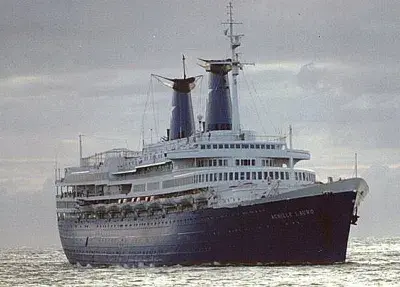
(Photo retrieved from Wikipedia on September 5, 2023. Originally taken by D. R. Walker, license CC BY-SA 3.0)
Achille Lauro first operated as ocean liner Willem Ruys. In 1965, she was purchased by Italian businessman Achille Lauro, who had it converted into a cruise ship. During her service history, she underwent a series of misfortunate events. The first of which occurred in 1953 when she struck Angelina Lauro. Thankfully, neither of the ships sustained enough damage to take them out of service.
In 1975, she collided with the cargo ship Youseff, and in 1985, the ship was hijacked by members of the Palestine Liberation Front. There were also four onboard fires or explosions that took place in 1965, 1972, 1981, and 1994. The final fire would be the incident that would cause the ship to sink.
On November 30, 1994, Achille Lauro caught fire while sailing to South Africa. There were 979 passengers and crew members onboard. The majority of those on the ship were able to evacuate the following morning when a list was noticed. Only two people were killed before the ship finally sank on December 2.
Sun Vista (May 1999)

(Photo retrieved from Wikipedia on September 5, 2023. Originally taken by John Ward, license CC BY-SA 4.0)
Sun Vista entered service in 1963 as the SS Galileo Galilei for the Lloyd Triestino line. Between then and when she eventually sank in 1999, she sailed for five different cruise lines, including Celebrity Cruises.
In fact, she was Celebrity Cruises' first-ever cruise ship, Meridian. She was transferred to Sun Cruises and renamed Sun Vista in 1997. This was the last line that she would ever sail with.
On May 20, 1999, a fire broke out in the ship's engine room. She sank a few hours later in the early morning hours of May 21 while in the Strait of Malacca. Thankfully, all passengers and crew were able to make it off the ship safely.
Britanis (October 2000)
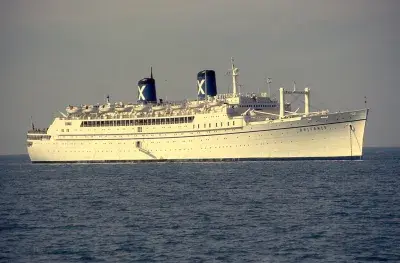
(Photo retrieved from Wikipedia on September 5, 2023. Originally uploaded by Lev. Anthony and authored by René Beauchamp, license CC BY-SA 4.0)
Britanis, which entered service as SS Monterey as a luxury ocean liner in 1932, eventually began to sail for Chandris under their "Fantasy Cruises" division in February 1971. When Chandris decided to focus on the Celebrity Cruises brand, all Fantasy Cruises operations ceased. It would not be until 1998 that she would be sold to AG Belofin and renamed Belofin-1.
Rather than follow through with their original plans, she was instead sold to scrappers. While en route to a scrapyard from Brazil, Britanis developed a leak in the aft of the ship. There wasn't anybody onboard, as it was being pulled by a tugboat, so the ship was cut free and capsized off the coast of Cape Town, South Africa.
SeaBreeze (December 2000)
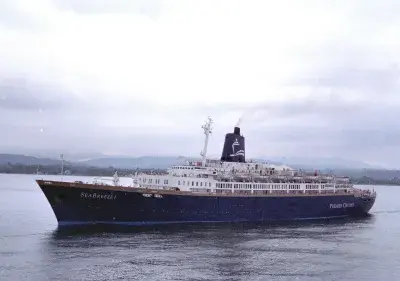
(Photo retrieved from Wikipedia on September 5, 2023. Originally uploaded by Lev. Anthony and authored by Leo Johannes, license CC BY-SA 4.0)
When launched in 1958, SeaBreeze was named Federico C. and sailed for Costa Cruises. In 1983, she was transferred to Premier Cruises and renamed three different times.
Premier Cruises went out of business in September 2000, resulting in the ship's operations to be immediately ceased and laid up.
While en route from Halifax, Nova Scotia to Charleston, South Carolina after being purchased by Cruise Ventures III, she sank off the East Coast about 225 nautical miles from Virginia. Only 34 crew members were onboard, all of which were able to be safely rescued.
The ship sank as a result of the boiler breaking off, causing a good deal of damage to the vessel.
MV Explorer (November 2007)

(Photo retrieved from Wikipedia on September 5, 2023. Originally uploaded and authored by Constantine, license CC BY-SA 4.0)
MV Explorer began her career in 1969 as MS Lindblad Explorer as the very first ship of her kind that was used to sail through the Antarctic Ocean.
On November 11, 2007, she set sail from Ushuaia, Argentina on a 19-day cruise. She hit an iceberg after visiting the Falkland Islands in the Bransfield Strait on November 23, which resulted in a gash in the ship's hull that allowed water to enter.
All 91 passengers, 53 crew, and 9 guides were able to make it off the ship on lifeboats, where they remained for five hours until they were able to be rescued by MS Nordnorge.
MS Sea Diamond (April 2007)

(Photo retrieved from Wikipedia on September 5, 2023. Originally uploaded and authored by 大友ディミトリ)
For the majority of her time at sea, MSC Sea Diamond operated under the name Birka Princess for Birka Line. In 2006, she was sold to Louis Cruises Line and renamed MS Sea Diamond.
One year later, she ran aground on a reef near the island of Santorini. Onboard were 77 students from Paisley Magnet School in North Carolina.
While it was initially reported that all passengers and crew made it off safely, two French citizens, Jean Christophe Allain, 45, and his daughter Maud, 16, were reported missing. Their bodies were never found.
Greek authorities eventually announced that they were going to charge the captain and five other officers with negligence.
Costa Concordia (January 2012)
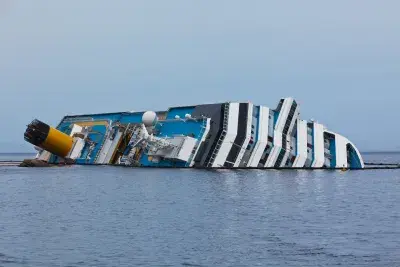
The capsizing of the Costa Concordia is one of the most well-known modern day maritime disasters. She was the first ship of Costa Cruises' Concordia Class, entering service in 2006.
On January 13, 2012, the ship departed on a 7-night Mediterranean cruise with 3,206 passengers and 1,023 crew members onboard. The ship was en route to its very first port when Captain Francesco Schettino decided to veer off of the original course, sailing extremely close to the island of Giglio.
Less than three hours after setting sail, or around 9:45pm, the ship came into contact with a large rock that resulted in a 174 foot gash in the port side of the hull. Due to the flooding, the ship soon lost power. The position of the ship's rudder also meant that it was unable to be steered. Soon after, the ship began to tilt towards the starboard side. The evacuation took over six hours and caused the deaths of 32.
An investigation was opened that focused on the faults in the procedures that were taken by the crew and, most specifically, Schettino, as he left the ship while passengers were still onboard.


